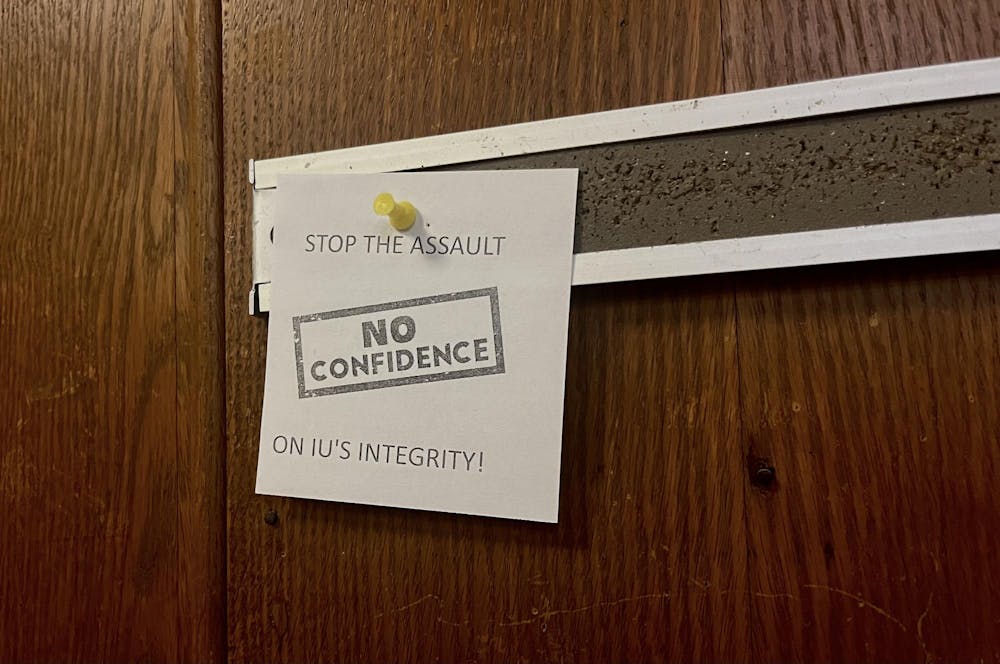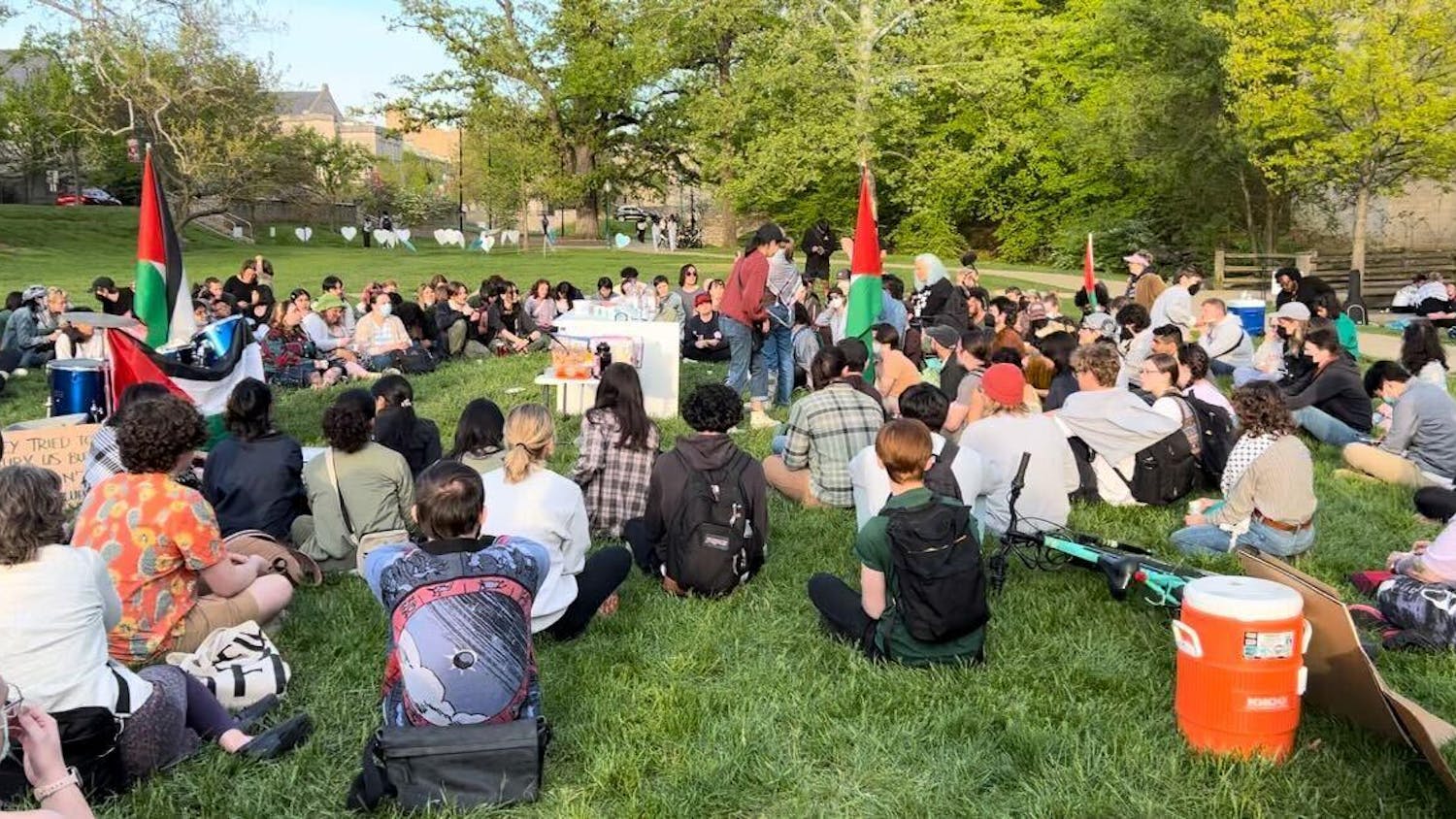IU faculty will meet to consider a vote of no confidence for President Pamela Whitten, Provost Rahul Shrivastav and Vice Provost for Faculty and Academic Affairs Carrie Docherty at 2:30 p.m. April 16 in the IU Auditorium.
Addressing the Bloomington Faculty Council on Tuesday, BFC President Colin Johnson read aloud the text of the vote of no-confidence petition while the provost looked on beside him.
The petition, submitted March 27, called for an all-faculty meeting to consider a vote of no confidence following several controversial university decisions. It garnered 226 signatures in a week but needed only 50 to trigger the all-faculty meeting.
“The current IU administration is encroaching on both academic freedom and shared governance by sanctioning faculty and by canceling art exhibits at the Eskenazi Museum,” the petition reads. “These recent actions, when taken together with the administration's failure to proactively and effectively stand against the Indiana legislature's violations of academic freedom and faculty protections, its fortunately unsuccessful attempt to separate Kinsey from IU, its disregard toward the 2022 faculty vote in support of graduate student workers, and its refusal to publicly support IU faculty member Dr. Caitlin Bernard, motivate this petition for an all-faculty meeting to consider a vote of no confidence.”
The most recent controversial decisions include the suspension of professor Abdulkader Sinno for allegedly misrepresenting a Palestine Solidarity Committee event on a room reservation form, the cancelation of Palestinian painter Samia Halaby’s exhibit due to unspecified security concerns and the attempt to establish part of the Kinsey Institute as a separate entity from the university, which took some faculty and staff by surprise when it was initially proposed.
The group of faculty members who organized the petition form the Vote of No Confidence taskforce. Three taskforce members spoke to the IDS and asked to remain anonymous, fearing it would jeopardize grants or their position at the university.
While the petition, which was sent out to an Association of University Professors email list and shared by faculty March 21, gathered far more signatures than the minimum required, a member of the VoNC taskforce said more would have signed it but were afraid of being fired or not promoted, particularly untenured and junior faculty.
If more than 800 faculty attend the meeting, the vote can take place on the spot. If more than 200 but less than 800 faculty attend, the group will debate the resolution and have faculty vote electronically later. In either case, only a simple majority is required to pass the resolution.
Johnson said at the BFC meeting that the vote will likely be split into three separate resolutions, with 45 minutes of debate allotted for each one. The meeting will replace the BFC’s final official meeting because the April 16 date was the only time the IU Auditorium — the sole location on campus able to hold all of IU’s faculty — was available. Johnson urged all faculty to show up and treat the issue with care.
In an address to the council immediately after Johnson spoke, Shrivastav reiterated that the administration is doing what is best for the university but said not everyone will understand or agree with the decisions they make.
A vote of no confidence does not have a binding effect on the administration, but it sends a dramatic message to the university, a VoNC taskforce member said. The last time faculty passed a vote of no confidence resolution was in 2005, when then-president Adam Herbert resigned. Faculty at the time cited weak leadership and Herbert’s inability to select a chancellor for the Bloomington campus.
A survey of 150 no confidence votes across U.S. universities from 1989-2016 showed that around half of the presidents resigned within a year of the vote. No confidence votes have spiked recently, with more than 20 votes taking place in 2021. Researchers have found these votes are often due to a sense that shared governance is being ignored, usually following major academic restructuring and financial affairs. Shared governance involves a partnership between administration and faculty in governing the university, a long-standing tradition in American higher education. Additional research has illustrated a shift from faculty-centric university presidencies to administrators that rely increasingly on external actors like donors and other stakeholders, contributing to faculty displeasure.
The member said the resolution is powerful because it signals faculty are upset and will not be ignored and administrations need faculty cooperation to run a university successfully.
In a statement to the IDS, IU Executive Director of Media Relations Mark Bode wrote that universities are at an especially challenging point in time.
“The current climate in higher education is uniquely challenging, with universities addressing and adapting to unprecedented new pressures and demands. Indiana University continues to evolve in ways that keeps it on a positive and powerful trajectory forward,” he wrote. “As it confronts these new realities, IU remains driven by an unwavering commitment to student success and opportunity resulting from valued collaboration with our faculty and staff.”
Faculty organizers describe broad sense of mistrust
The campus climate for faculty is one of fear and mistrust of the administration, another member of the VoNC taskforce said.
“I feel like that is almost universal,” he said.
He sees the no-confidence movement as a way to hold the university accountable and encourage a less centralized, administration-focused decision-making process. Good starting points, he said, would be a retraction of Sinno’s suspension and a formal apology issued to Halaby.
A third member of the VoNC said he wanted to help organize the vote because he believes the administration has undermined faculty’s traditional role in shared governance.
Though he’s seen mild dissent stemming from the belief that the time for a no confidence vote isn’t right or that it won’t do any good, he hasn’t seen much of a defense of Whitten.
Dissatisfaction with the administration has been brewing for three years, he said, but the movement was truly sparked when news of Sinno’s suspension and the cancelation of Halaby’s art exhibit broke in January.
“It really seemed like free speech, free academic inquiry and faculty governance were collapsing at IU,” he said. “It was very alarming.”
Though he doesn’t think Whitten will resign if the vote goes through, he said he hopes the petition will encourage the administration to engage with faculty before making decisions.
“We definitely want to get her attention, and we want her to know very clearly that faculty voices aren't being listened to and faculty voices need to be listened to,” he said.




